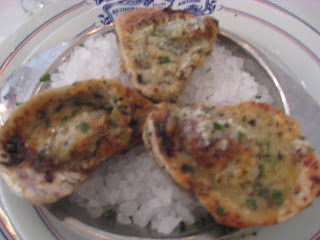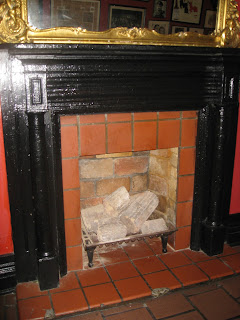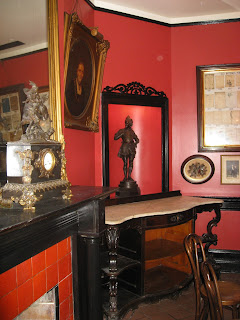Antoine's Restaurant in the heart of New Orleans' French Quarter is far more than just a restaurant. It's a time capsule filled with French-Creole influence and a side of oysters Rockefeller.
At the end of last Summer I had a memorable outing at world famous Antoine's Restaurant with my good friend Lisa. Having been established in 1840 by Antoine Alciatore of Bordeaux France where I just came back from spending almost two weeks. Antoine's is a Louisiana Creole cuisine restaurant located at 713 rue St. Louis (St. Louis Street) in the French Quarter of New Orleans, Louisiana. It has the distinction of being the oldest family run restaurant in the United States. The setting is simply elegant and Old World. Antoines has a catacomb of multiple historic rooms, each with its own unique flare and artifacts to ooh and ahh at. The atmosphere and service is great for a fancy get together with friends, family, and coworkers. The food is always top notch, their chef must get compliments all the time because yeah... the food will definitely leave your palate happy. The service is great too, as it takes years to become a waiter there! They are in the know about the food as well as the history behind (and hanging on) the walls of Antoine's Restaurant.
The china plate at Antoine's
This New Orleans institution, it is notable for being the "inventor" of several famous dishes, such as Oysters Rockefeller, Pompano en Papillote, Eggs Sardou and Pigeonneaux Paradis. Antoine's Cookbook, compiled by Roy F. Guste (the fifth-generation proprietor) features hundreds of recipes from the Antoine's tradition. The restaurant is also known for its VIP patrons (including several U.S. presidents and Pope John Paul II).
Oysters Bienville: This succulent dish named in his honor was originally created at Antoine's by Chef Auguste Michel.
Antoine's features a 25,000 bottle capacity wine storage and 14 dining rooms of varying sizes and themes, with several featuring Mardi Gras krewe memorabilia. The lengthy menu (originally only in French, now in French and English) features classic French-Creole dishes. By tradition, Antoine's is closed to the general public on Thanksgiving, Christmas and Mardi Gras. The restaurant can be reserved for private parties on these "Closed Days." Advance reservations are required for dining during Mardi Gras and on weekends. The executive chef as of November 2012 is Michael Regua.
Poulet aux champignons -
Chicken breast sautéed with fresh mushrooms, butter and garlic.
Dessert
Antoines Restaurant New Orleans Rex Room
Born in France in 1822, Antoine Alciatore came to the New World at the age of 18 aiming to establish a business of his own, and after arriving in New Orleans in 1840, he opened a pension – a boarding house and restaurant in the French Quarter – that was simply to be known as “Antoine’s.”
The walls are adorned with photos of Mardi Gras royalty and memorabilia, including crowns and scepters from many years long past.
In ill health by 1874, Alciatore returned to France, where he died and was buried. Under Antoine’s wife’s tutelage, their son Jules served as an apprentice, running the restaurant for six years before traveling to France, where he served in the great kitchens of Paris, Strasbourg and Marseilles. He returned to New Orleans and became chef of the famous Pickwick Club in 1887, before his mother summoned him to head the House of Antoine.
His genius was in the kitchen, where he invented Oysters Rockefeller, so named after Standard Oil Founder John D. Rockefeller, for the richness of the sauce. While its namesake reportedly despised its title, Oysters Rockefeller is widely considered one of the greatest culinary creations of all time, with the recipe remaining a closely guarded secret.
Jules was succeeded by one of his three children, Roy, who followed in his father’s footsteps and led the restaurant for almost 40 years through some of the country’s most difficult times, including Prohibition and World War II, until his death in 1972. His legacy includes the invention of famous dishes such as Oysters Foch and Eggs Sardou, as well as the creation of several of its famous dining rooms and their white tablecloth décor. Roy’s vision and meticulous management of the restaurant solidified the international culinary stature of Antoine’s and firmly established it as a dining destination unto itself.
Antoines Restaurant New Orleans Rex Room
The walls are adorned with photos of Mardi Gras royalty and memorabilia, including crowns and scepters from many years long past.
Antoines Restaurant New Orleans Rex Room
The walls are adorned with photos of Mardi Gras royalty and memorabilia, including crowns and scepters from many years long past.
The walls are adorned with photos of Mardi Gras royalty and memorabilia, including crowns and scepters from many years long past.
Antoines Restaurant New Orleans Rex Room
The long and narrow Wine Cellar, which measures 165-feet long and 7-feet wide, holds approximately 25,000 bottles when fully stocked. It is a legendary space and can be viewed from a small window on Royal Street.
Proteus Room
Proteus Room
Proteus Room
The 1840 Room, fashioned in the style of the period, is a charming salon for dining. Photographs of successive generations of the Alciatore family also dot the room and add to the richness of the warm, red interior. It replicates a fashionable dining room from that time and is also a museum of sorts, housing a Parisian cookbook circa 1659, and the restaurant's silver duck press among other treasures.
The Widow Clicquot widow who built a champagne empire, became a legend in her tumultuous times, and showed the world how to live with style.
The 1840 Room replicates a fashionable dining room from the era of the restaurant’s founding and is also a museum of sorts, housing a Parisian cookbook circa 1659, and the restaurant’s antique silver duck press, among other treasures. Portraits of successive generations of the Alciatore family also dot the room and add to the richness of the warm, red interior.
19th century oil portraits of Antoine's family members
The 1840 Room, fashioned in the style of the period, is a charming salon for dining. Photographs of successive generations of the Alciatore family also dot the room and add to the richness of the warm, red interior. It replicates a fashionable dining room from that time and is also a museum of sorts, housing a Parisian cookbook circa 1659, and the restaurant's silver duck press among other treasures.
The 1840 Room replicates a fashionable dining room from the era of the restaurant’s founding and is also a museum of sorts, housing a Parisian cookbook circa 1659, and the restaurant’s antique silver duck press, among other treasures. Portraits of successive generations of the Alciatore family also dot the room and add to the richness of the warm, red interior.
The 1840 Room, fashioned in the style of the period, is a charming salon for dining. Photographs of successive generations of the Alciatore family also dot the room and add to the richness of the warm, red interior. It replicates a fashionable dining room from that time and is also a museum of sorts, housing a Parisian cookbook circa 1659, and the restaurant's silver duck press among other treasures.
Marble mantel.
Antoine’s legacy is a storied one, and countless world leaders and celebrities have dined there. Lining the walls are photographs of the rich and famous who have feasted amid the splendor including Franklin Roosevelt, Pope John Paul II, the Rolling Stones, George W. Bush, Bill Clinton, Brad Pitt, Morgan Freeman, Bruce Willis, Tom Cruise, Kate Hudson, Jimmy Buffett, Whoopi Goldberg, Bob Hope and Bing Crosby to name only a few.









































































No comments:
Post a Comment